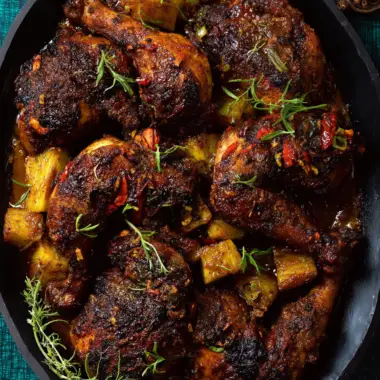This saffron-infused Persian Chicken is a warm, comforting dish that celebrates the depth and elegance of Middle Eastern cooking. Each piece of chicken is seared to a golden crisp and then gently braised in a rich, spiced broth flavored with turmeric, lemon, and caramelized onions. A touch of saffron water brings color and a subtle floral note, creating layers of taste in every bite. Perfect for a cozy dinner or impressing guests with global flavors, this dish is both rustic and refined. It pairs beautifully with fluffy basmati rice or warm flatbread and is easy enough for weeknights yet elegant enough for special occasions. Add a sprinkle of dried barberries or golden raisins for a sweet-tart finish that lifts the whole plate.
Full recipe:
Ingredients:
-
2 lbs bone-in, skin-on chicken thighs or drumsticks
-
1 large onion, thinly sliced
-
3 garlic cloves, minced
-
2 tablespoons olive oil
-
1 tablespoon butter
-
1 teaspoon ground turmeric
-
¼ teaspoon ground cinnamon
-
½ teaspoon paprika
-
Salt and pepper to taste
-
Juice of 1 lemon
-
1 tablespoon tomato paste
-
1 cup chicken broth
-
A pinch of saffron threads, steeped in 2 tablespoons hot water
-
Optional: dried barberries or golden raisins for garnish
-
Chopped fresh parsley for serving
Directions:
-
In a large bowl, mix chicken with salt, pepper, lemon juice, turmeric, and paprika. Let marinate for at least 1 hour.
-
In a large skillet or Dutch oven, heat olive oil and butter over medium heat. Add sliced onions and sauté until golden brown.
-
Add garlic and cook for another minute. Add marinated chicken to the pan and sear until golden on all sides.
-
Stir in tomato paste, cinnamon, and saffron water. Add chicken broth and bring to a gentle simmer.
-
Cover and cook on low heat for 35–45 minutes, until the chicken is tender and the sauce has thickened.
-
Garnish with dried barberries or golden raisins and fresh parsley before serving.
Prep Time: 15 minutes (plus 1 hour marinating) | Cooking Time: 45 minutes | Total Time: ~1 hour active (+ marinating)
Kcal: 385 kcal per serving | Servings: 4 servings
The Rich History Behind Persian Chicken
Persian cuisine is known for its deep appreciation of herbs, spices, and balance—every dish is crafted with care to harmonize flavor, texture, and aroma. Persian Chicken, also known as “Zereshk Polo ba Morgh” when served with barberries and rice, is one of the most beloved traditional dishes of Iran. The version featured in this recipe—a saffron-infused braised chicken cooked with turmeric, garlic, and onions—is a simpler yet incredibly flavorful adaptation that still holds true to Persian culinary roots.
This dish reflects the Persian cooking philosophy: using few ingredients, but letting them shine through careful technique and layering of flavors. In many Persian households, this chicken is a staple for both everyday meals and formal gatherings. Whether served at a family dinner or on a Nowruz (Persian New Year) table, this golden, aromatic chicken always impresses.
Why This Persian Chicken Recipe is So Special
This version of Persian Chicken is designed to be both authentic and approachable. You don’t need hard-to-find ingredients or elaborate equipment. With just a few key items—turmeric, lemon juice, saffron, and tomato paste—you can create a dish that feels both exotic and familiar. What sets it apart from other braised chicken recipes is its flavor layering. Each step, from marinating the chicken to simmering in saffron broth, builds depth and character.
Another special element is the balance of taste and texture. The chicken is browned for a golden crust, then gently simmered until it becomes fall-off-the-bone tender. The broth becomes rich and concentrated, with bright notes from lemon and warm tones from saffron and cinnamon.
This is a dish that looks like it took hours to prepare, but is actually quite simple—making it ideal for weeknights and weekend entertaining alike.
The Magic of Saffron and Turmeric
The two most important spices in this recipe are saffron and turmeric, each playing a unique role.
-
Saffron, known as the world’s most expensive spice by weight, lends a subtle floral aroma, a golden hue, and a luxurious depth to the dish. It is a hallmark of Persian cuisine and is often steeped in hot water before being added to food to release its color and flavor.
-
Turmeric provides a warm earthiness and beautiful yellow color. It’s not just for taste—it’s also renowned for its anti-inflammatory properties and health benefits.
Together, these spices give the chicken its signature Persian flavor profile—earthy, aromatic, and slightly tangy, with a touch of sweetness.
Health Benefits of Persian Chicken
Persian Chicken is not just comforting and delicious—it also brings nutritional value. Here’s why this dish can be a healthy option:
-
High in Protein: Bone-in chicken thighs and drumsticks provide lean, satisfying protein, essential for muscle repair and overall energy.
-
Anti-inflammatory Spices: Turmeric and saffron have long been praised in traditional medicine for their anti-inflammatory, antioxidant, and even mood-boosting benefits.
-
Healthy Fats: Olive oil and a small amount of butter add healthy fats that aid in absorbing fat-soluble vitamins from the spices and aromatics.
-
Low in Sugar and Processed Ingredients: Unlike many Western-style braised dishes, this Persian chicken contains no added sugars or processed sauces.
When served with whole grain basmati rice or a fresh salad, this meal becomes a wholesome, nourishing option perfect for those following Mediterranean or anti-inflammatory diets.
Tips for the Best Persian Chicken
Want to make your Persian Chicken even better? Here are a few expert tips:
-
Marinate Longer: Although an hour is enough, marinating the chicken for up to 6 hours deepens the flavor and helps tenderize the meat.
-
Use Bone-In, Skin-On Chicken: This ensures juiciness and contributes to a richer sauce. You can always remove the skin after cooking if preferred.
-
Caramelize the Onions Slowly: Don’t rush this step! A golden-brown onion base creates the backbone of flavor in Persian stews.
-
Steep the Saffron Properly: Use freshly boiled water and let the saffron sit for at least 10 minutes to unlock its full aroma and color.
-
Simmer Gently: A low simmer ensures the chicken becomes tender without falling apart or drying out.
Variations You Can Try
This recipe is quite adaptable depending on what you have on hand or your personal taste:
-
Add Dried Fruit: Golden raisins or barberries can be added toward the end for a tart-sweet contrast that enhances the savory base.
-
Make it Spicy: Add a pinch of chili flakes or cayenne if you want a little heat.
-
Use Chicken Breast: If you prefer white meat, you can use bone-in or boneless chicken breast—just adjust the cooking time to avoid dryness.
-
Serve Over Potatoes: Instead of rice, serve the braised chicken over a bed of roasted or mashed potatoes for a rustic twist.
-
Add Chickpeas: For extra protein and texture, stir in a cup of canned chickpeas in the last 10 minutes of cooking.
These ideas let you keep the essence of the dish while tailoring it to your needs or pantry.
Pairing Suggestions and Serving Ideas
Traditionally, Persian Chicken is served with saffron rice or polo (Persian-style steamed rice), often alongside a tangy cucumber-yogurt salad called mast-o-khiar or a chopped herb salad with lemon and olive oil.
Other great pairings include:
-
Flatbreads like lavash or pita, perfect for soaking up the saffron broth
-
Pickled vegetables or torshi for tangy contrast
-
Roasted eggplant or zucchini, to add depth and color to the plate
-
Chilled yogurt drinks like doogh (a salty Persian yogurt beverage) to balance the warm spices
These sides help complete the meal while keeping it traditional and vibrant.
How to Store and Reheat
Persian Chicken stores beautifully and the flavor even deepens after a day. Here’s how to keep it fresh:
-
Refrigerator: Store leftovers in an airtight container for up to 4 days.
-
Freezer: This dish can be frozen for up to 2 months. Let it cool completely before storing.
-
Reheat: Gently reheat in a saucepan over medium-low heat with a splash of broth or water to loosen the sauce.
This makes it a great make-ahead meal for busy weeks or elegant batch cooking.
Persian Chicken for Special Occasions
Although simple enough for weeknights, this dish is also perfect for special occasions. Its golden color and rich aroma make it worthy of holiday tables, dinner parties, or cultural celebrations. Pair it with jeweled rice and garnish with slivered almonds or pomegranate seeds for a show-stopping presentation.
Because saffron is considered luxurious, this dish also makes a thoughtful meal to serve guests—it tells them they’re special, without the need for extravagant ingredients or complex techniques.
Cultural Relevance and Global Appeal
Persian Chicken is more than a recipe—it’s a taste of Iranian hospitality. In Persian culture, food is deeply intertwined with family, celebration, and respect for tradition. Meals are shared communally, with an emphasis on quality and care.
Today, as global palates grow more adventurous, Persian cuisine is finding its place in kitchens around the world. This dish, in particular, is ideal for introducing newcomers to Persian flavors. It combines familiar ingredients with bold spices, creating a bridge between classic comfort food and exotic exploration.
Conclusion
Persian Chicken is a dish that satisfies both body and soul. Rich in flavor, simple to prepare, and deeply rooted in culture, it offers everything we love about home cooking—comfort, nourishment, and connection. With its golden color, aromatic broth, and tender chicken, every bite tells a story of tradition and taste. Whether you’re exploring Persian cuisine for the first time or rediscovering a beloved classic, this saffron-tinted chicken dish is a timeless treasure that deserves a spot in your regular rotation. It’s a delicious way to expand your culinary horizons—and bring a touch of Persian magic to your table.








